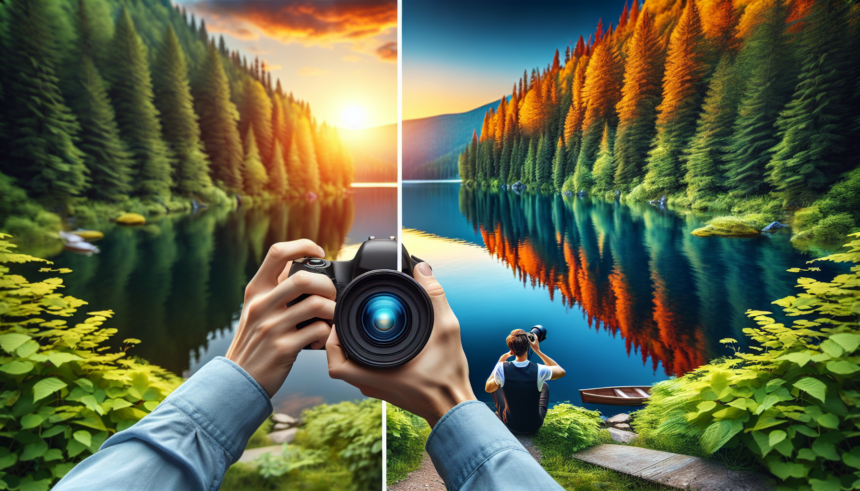Image blur is a common issue in digital photography that can detract from an otherwise perfectly composed shot. Understanding the causes of image blur and how to prevent it can significantly improve the quality of your photographs. This article delves into the various factors that contribute to image blur and provides practical solutions to minimize its occurrence.
Causes of Image Blur
1. Camera Shake
Camera shake is one of the most prevalent causes of image blur, especially in handheld photography. It occurs when the camera moves while the shutter is open, resulting in a blurred image.
Solution: To prevent camera shake, use a tripod or a stable surface to support your camera. Additionally, consider using a remote shutter release or the camera’s timer function to minimize movement when pressing the shutter button.
2. Subject Movement
When photographing moving subjects, such as children or animals, their movement during the exposure can cause blur.
Solution: To capture moving subjects without blur, use a faster shutter speed. Increasing the ISO setting or opening the aperture can help achieve a faster shutter speed without underexposing the image.
3. Incorrect Focus
Blur can also result from incorrect focus. If the camera’s focus point is not set correctly, the main subject may appear blurred while other parts of the image remain sharp.
Solution: Ensure that the focus point is set on the subject of interest. Use autofocus modes wisely and consider manual focus for greater control in challenging situations.
4. Depth of Field Issues
A shallow depth of field can cause parts of the image to be out of focus, leading to a blurred effect.
Solution: Adjust the aperture to increase the depth of field. A smaller aperture (larger f-number) will result in more of the scene being in focus. Be mindful of the trade-off between depth of field and the amount of light entering the lens.
5. Lens Aberrations
Certain lens imperfections, such as chromatic aberration and spherical aberration, can cause blurring and distortions in the image.
Solution: High-quality lenses with advanced optical designs can minimize these aberrations. Additionally, software corrections in post-processing can help reduce their impact.
6. Environmental Factors
Environmental factors such as wind, rain, or fog can affect image clarity and lead to blur.
Solution: Protect your camera from harsh weather conditions and use a lens hood or filters to mitigate the impact of environmental factors. Consider shooting from sheltered locations or during more favorable weather conditions.
Solutions to Minimize Image Blur
1. Use a Tripod
A sturdy tripod is one of the most effective tools to eliminate camera shake. It provides a stable platform for your camera, ensuring sharp images even at slower shutter speeds.
2. Opt for Image Stabilization
Many modern cameras and lenses come equipped with image stabilization technology. This feature compensates for minor movements, reducing the risk of blur caused by camera shake.
3. Increase Shutter Speed
Using a faster shutter speed is crucial when photographing moving subjects or shooting handheld. A faster shutter speed reduces the chances of both camera shake and subject movement causing blur.
4. Adjust ISO and Aperture Settings
Higher ISO settings and wider apertures allow for faster shutter speeds while maintaining proper exposure. However, be cautious with high ISO settings, as they can introduce noise into the image.
5. Utilize Burst Mode
Burst mode allows you to take multiple shots in quick succession. This increases your chances of capturing a sharp image, especially with moving subjects.
Post-Processing Techniques
1. Sharpening
Image editing software offers sharpening tools that can enhance image clarity. Be cautious not to over-sharpen, as this can introduce artifacts and degrade image quality.
2. Noise Reduction
Reducing noise in high-ISO images can help maintain detail and clarity. Most photo editing programs include noise reduction features that can be applied selectively to minimize its impact on the overall image.
3. Lens Correction
Post-processing software often includes lens correction profiles that can fix issues like chromatic aberration and distortion. Applying these corrections can improve image sharpness.
4. Micro-Contrast Adjustments
Adjusting micro-contrast can enhance fine details and give the impression of a sharper image. These adjustments can be made with care to avoid exaggerating noise or artifacts.
5. Selective Sharpening
Applying sharpening selectively to specific areas of the image, rather than globally, can maintain a natural look while improving sharpness where needed.
Conclusion
Understanding the causes of image blur and implementing effective solutions can significantly enhance your digital photography. By addressing issues such as camera shake, subject movement, focus accuracy, and environmental factors, photographers can capture sharper, more detailed images. Additionally, leveraging post-processing techniques can further refine image quality and correct any residual blur. Whether you are an amateur or a professional photographer, these insights and strategies will help you achieve clearer, more impactful photographs.
FAQs
1. How can I prevent blur in low-light conditions?
To prevent blur in low-light conditions, use a tripod to stabilize the camera and avoid camera shake. Increase the ISO setting to allow for a faster shutter speed, and use a wider aperture to let in more light.
2. What is the best shutter speed to avoid motion blur?
The best shutter speed to avoid motion blur depends on the speed of the subject. For general handheld photography, a minimum shutter speed of 1/60s is recommended. For fast-moving subjects like sports or wildlife, a shutter speed of 1/500s or faster is more suitable.
3. Can image stabilization replace the need for a tripod?
While image stabilization can significantly reduce blur caused by camera shake, it may not entirely eliminate the need for a tripod, especially in very low-light conditions or when using long exposure times. A tripod provides the most stability and is essential for certain types of photography, such as long-exposure or night photography.
4. How does aperture affect image blur?
The aperture affects the depth of field in an image. A wide aperture (small f-number) creates a shallow depth of field, which can lead to blurred backgrounds and foregrounds. A smaller aperture (large f-number) increases the depth of field, keeping more of the scene in focus and reducing overall blur.
5. Is post-processing necessary for every photo to reduce blur?
Post-processing is not always necessary for every photo, especially if proper techniques are used during shooting to minimize blur. However, post-processing can enhance image sharpness and correct minor blurs that may not be avoidable during capture. Adjustments such as sharpening, noise reduction, and lens corrections can refine the photo and improve its overall quality.










